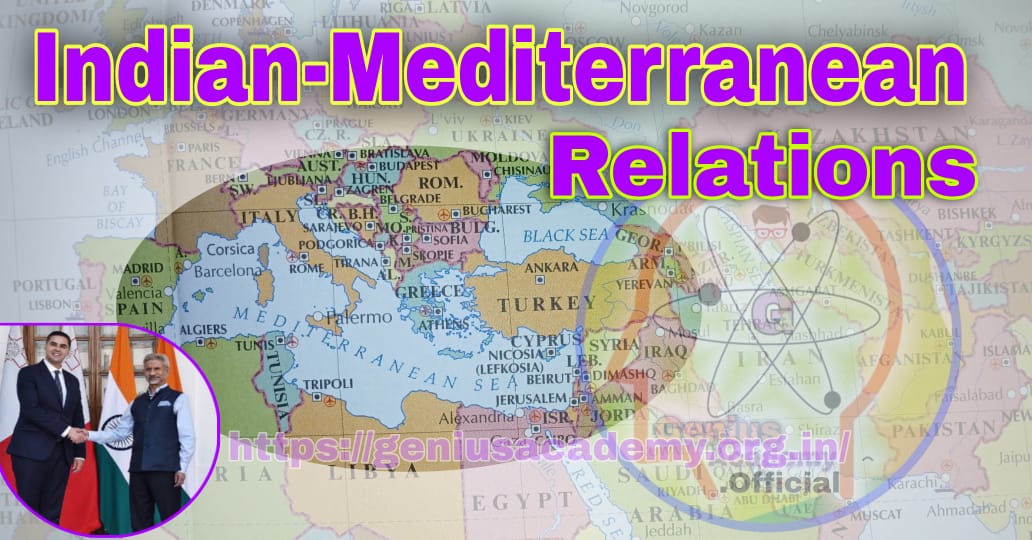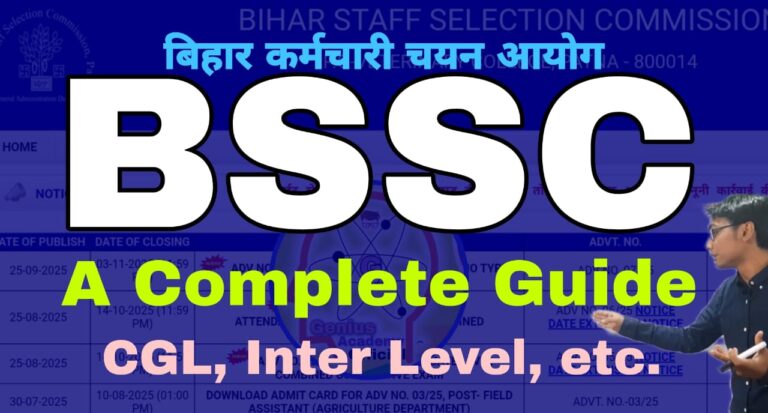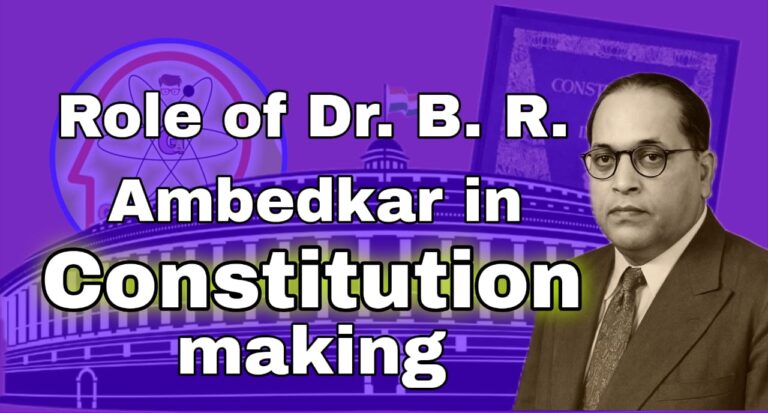Strengthening India-Mediterranean Relations: Strategic and Economic Perspectives
The recent address by External Affairs Minister S. Jaishankar at the 10th MED Mediterranean Dialogue in Rome highlights the evolving and mutually beneficial partnership between India and the Mediterranean region. The Mediterranean, with its rich history, strategic location, and cultural diversity, has emerged as a vital area for India’s foreign policy and economic ambitions. This detailed discussion explores the historical, political, economic, and cultural dimensions of the India-Mediterranean relationship, along with key challenges and the way forward.
1. Understanding the Mediterranean Region
1.1 Geography and Composition
The Mediterranean region includes:
- Southern Europe:— Spain, France, Monaco, Italy, Slovenia, Croatia, Bosnia and Herzegovina, Montenegro, Albania, Greece, Malta, and Cyprus.
- North Africa:— Egypt, Libya, Tunisia, Algeria, and Morocco.
- West Asia:— Turkey, Syria, Lebanon, Israel, and Palestine.

Map source: Oxford School Atlas
1.2 Strategic Significance
The region serves as a critical bridge connecting three continents: Europe, Asia, and Africa. Historically, it has been a hub of global commerce, politics, and culture, influencing trade routes and geopolitical strategies. For India, the Mediterranean offers access to major European markets and enhances its Indo-Pacific policy by bridging connections to Africa and the Middle East.
2. India-Mediterranean Relations
2.1 Historical Ties and Cultural Exchanges
India’s engagement with the Mediterranean dates back centuries, marked by:
- Trade Relations:— Historical records show robust trade with the Roman Empire and the Greeks. The ancient port city of Muziris (on the Malabar Coast) was a prominent hub for the exchange of spices, exotic goods, and gold.
- Cultural Interactions:— These exchanges facilitated the blending of art, ideas, and religious practices, laying the groundwork for enduring connections.
2.2 Strategic and Geopolitical Importance
- Indo-Pacific Strategy:— The Mediterranean acts as a western extension of India’s Indo-Pacific vision, promoting a free, open, and inclusive maritime domain.
- Defense Collaborations:— India has strengthened ties with Mediterranean nations like Israel and Italy. For instance, India-Israel cooperation extends to defense technology and joint military exercises, while India-Italy defense collaborations include maritime domain awareness and production agreements.
- I2U2 Grouping:— Comprising India, Israel, the UAE, and the US, this grouping focuses on economic and security cooperation, enhancing India’s footprint in the region.
2.3 Economic and Trade Relations
India’s trade with Mediterranean nations has grown significantly, reaching approximately $80 billion annually.
- Key Sectors:— Fertilizers, energy, diamonds, water technology, defense, and cyber capabilities dominate trade.
- Infrastructure Investments:— Indian companies are actively involved in building infrastructure such as ports, airports, railways, and renewable energy projects, including green hydrogen initiatives.
2.4 Connectivity
The India-Middle East-Europe Economic Corridor (IMEC) is a transformative project aimed at improving connectivity between India, the Middle East, and Europe. Key features include:
- Facilitating trade integration.
- Involving countries like the UAE, Saudi Arabia, Jordan, Israel, and the European Union.
- Supporting India’s vision of becoming a global trade and supply chain hub.
2.5 Cultural and Diaspora Links
- The Mediterranean is home to approximately 460,000 Indians, 40% of whom reside in Italy.
- This diaspora strengthens cultural ties and contributes significantly to local economies while fostering mutual understanding.
3. Key Concerns for India in the Mediterranean Region
3.1 Geopolitical Instability
The Mediterranean region faces challenges such as:
- Conflict Zones:— Persistent tensions in Syria, Libya, and the Israel-Palestine conflict disrupt stability and economic cooperation.
- Regional Rivalries:— The success of projects like IMEC hinges on navigating these conflicts and ensuring smooth collaboration among stakeholders.
3.2 Energy Security
- Dependence on Imports:— India relies on Mediterranean countries for oil and gas, particularly from North Africa and the Middle East.
- Transition to Renewables:— The shift to renewable energy, including green hydrogen, requires strong investment partnerships and technology transfers.
3.3 Maritime and Regional Security
- Piracy and Illicit Activities:— Threats like piracy and illegal maritime trade disrupt freedom of navigation.
- Balanced Diplomacy:— India’s approach includes supporting a two-state solution in the Israel-Palestine conflict while fostering relations with both Israel and Iran.
3.4 Economic Integration Challenges
- Variations in regulatory frameworks and economic policies across Mediterranean countries create barriers to seamless trade and investment.
4. Recent Developments and Opportunities
4.1 Green Energy Initiatives
The Mediterranean’s focus on renewable energy aligns with India’s goals, especially in green hydrogen and solar power. Collaborative projects can:
- Enhance energy security.
- Support global climate change mitigation efforts.
4.2 Strengthening Multilateral Engagement
Through forums like the MED Mediterranean Dialogue and the I2U2 Grouping, India is increasing its diplomatic footprint and contributing to regional stability.
4.3 Infrastructure Investments
Projects under the IMEC corridor and other connectivity initiatives will:
- Enhance regional trade integration.
- Boost India’s role as a logistical and economic hub connecting Asia, the Middle East, and Europe.
4.4 Defense Partnerships
India’s defense ties with countries like Italy and Israel can be further expanded to include joint ventures in cyber security, unmanned systems, and maritime domain awareness.
5. The Way Forward
5.1 Navigating Regional Conflicts
- Promote dialogue and diplomatic initiatives to address issues like the Israel-Palestine conflict.
- Act as a neutral mediator where possible, leveraging India’s balanced foreign policy approach.
5.2 Enhancing Economic Integration
- Simplify trade regulations and encourage bilateral agreements to improve market access.
- Foster joint ventures in priority sectors like renewable energy, defense, and technology.
5.3 Strengthening Maritime Security
- Increase participation in joint naval exercises to ensure freedom of navigation.
- Collaborate on initiatives to combat piracy and illicit trade.
5.4 Deepening Cultural Engagement
- Leverage the Indian diaspora to build stronger people-to-people connections.
- Promote cultural exchanges through events, tourism, and educational programs.
5.5 Bolstering Connectivity
- Expedite the implementation of the IMEC to establish India as a key player in global trade routes.
- Encourage private sector investments in infrastructure projects.
Conclusion
India’s engagement with the Mediterranean region is a testament to its vision of fostering global partnerships that are inclusive, sustainable, and forward-looking. By addressing key challenges—geopolitical instability, energy security, regional conflicts, and economic integration—India can strengthen its ties with Mediterranean nations. The region’s strategic importance, coupled with collaborative initiatives like the IMEC and proactive diplomacy, positions India as a pivotal player in the Mediterranean’s stability and prosperity. Through sustained efforts, India can ensure that its relations with the Mediterranean region continue to thrive, fostering mutual growth and development.
Source:- PIB
Daily Mains Practice Questions
UPSC (CSE) Mains Questions on India-Mediterranean Relations
GS Paper 1: Culture and History
| [Q1.] Trace the historical trade and cultural connections between India and the Mediterranean region. How do these historical ties influence modern diplomatic relations?(250 words) |
| [Q2.] How did ancient trade routes like the one connecting Muziris with the Roman Empire shape the economic and cultural exchanges between India and the Mediterranean region?(250 words) |
GS Paper 2: International Relations
| [Q3.] Discuss the strategic and geopolitical importance of the Mediterranean region in shaping India’s foreign policy. How does the India-Middle East-Europe Economic Corridor (IMEC) align with India’s Indo-Pacific strategy? (250 words) |
| [Q4.] India’s historical and cultural ties with the Mediterranean region have laid a strong foundation for contemporary economic and diplomatic engagements. Critically evaluate this statement with examples. (250 words) |
| [Q5.] Examine the role of the Indian diaspora in strengthening cultural and economic ties between India and the Mediterranean region. (250 words) |
| [Q6.] Analyze the impact of regional instability and conflicts in the Mediterranean region on India’s strategic interests. Suggest measures India could adopt to navigate these challenges. (250 words) |
| [Q7.] What role can India play in addressing geopolitical conflicts in the Mediterranean region, such as the Israel-Palestine conflict, while maintaining its balanced foreign policy?(250 words) |
GS Paper 3: Economy and Energy Security
| [Q8.] Evaluate the role of the Mediterranean region in enhancing India’s energy security, particularly in the context of traditional and renewable energy sources. (250 words) |
| [Q9.] The Mediterranean region is a critical trade and investment partner for India. Discuss the sectors driving this economic relationship and the challenges faced. (250 words) |
| [Q10.] Analyze the significance of infrastructure projects like IMEC in boosting India’s connectivity with the Mediterranean region. What challenges could arise in its implementation?(250 words) |
FAQs on India-Mediterranean Relations
1. Why is the Mediterranean region strategically important for India?
Answer:—
The Mediterranean acts as a bridge connecting Asia, Europe, and Africa, aligning with India’s Indo-Pacific strategy. It offers critical maritime routes for global trade and energy transportation and serves as a hub for connectivity projects like the IMEC.
2. What is the India-Middle East-Europe Economic Corridor (IMEC), and why is it significant?
Answer:—
IMEC is an infrastructure initiative announced in 2023 to enhance trade and connectivity between India, the Middle East, and Europe. It aims to integrate supply chains, reduce logistics costs, and boost economic cooperation across continents, supporting India’s global trade ambitions.
3. How does India engage with Mediterranean countries in defense and security?
Answer:—
India engages through defense partnerships, joint military exercises, and maritime security collaborations. Key partners include Israel and Italy, with agreements focusing on technology transfer, cyber security, and maritime domain awareness.
4. What challenges does India face in strengthening relations with the Mediterranean region?
Answer:—
Key challenges include:
- Geopolitical instability due to regional conflicts (e.g., Israel-Palestine, Libya, Syria).
- Maritime security issues like piracy and illicit trade.
- Ensuring stable energy supplies amidst regional volatility.
- Navigating diverse regulatory frameworks for economic integration.
5. How does the Indian diaspora contribute to India-Mediterranean relations?
Answer:—
The Indian diaspora, numbering around 460,000 in the region, fosters cultural ties, contributes to local economies, and serves as a bridge for diplomatic and economic engagements. Their role is particularly significant in countries like Italy, which hosts a large share of the diaspora.
6. What are the key sectors driving India’s trade with Mediterranean countries?
Answer:—
Key sectors include fertilizers, energy (oil, gas, and renewables), diamonds, water technology, defense, cyber capabilities, and infrastructure development (ports, airports, and railways).
7. How does India balance its diplomatic relations in the Mediterranean region?
Answer:—
India adopts a balanced approach by engaging with conflicting parties like Israel and Palestine and promoting peace initiatives. It supports regional stability while advancing its strategic and economic interests.
8. What opportunities does the Mediterranean region offer for India in renewable energy?
Answer:—
The Mediterranean is a key partner in renewable energy projects, particularly green hydrogen and solar energy. Collaborations in this sector can enhance energy security and support global climate action goals.
9. What is the role of IMEC in India’s connectivity strategy?
Answer:—
IMEC enhances India’s connectivity by linking South Asia with the Middle East and Europe. It aims to reduce transit times, improve supply chain efficiency, and promote economic integration, strengthening India’s role in global trade
10. How can India address the challenges of regional instability in the Mediterranean?
Answer:—
India can address these challenges by:
- Promoting dialogue and mediation in conflict zones.
- Strengthening partnerships in defense and maritime security.
- Leveraging multilateral platforms like the MED Dialogue and I2U2 Grouping for collective solutions.
India can address these challenges by:
- Promoting dialogue and mediation in conflict zones.
- Strengthening partnerships in defense and maritime security.
- Leveraging multilateral platforms like the MED Dialogue and I2U2 Grouping for collective solutions.





